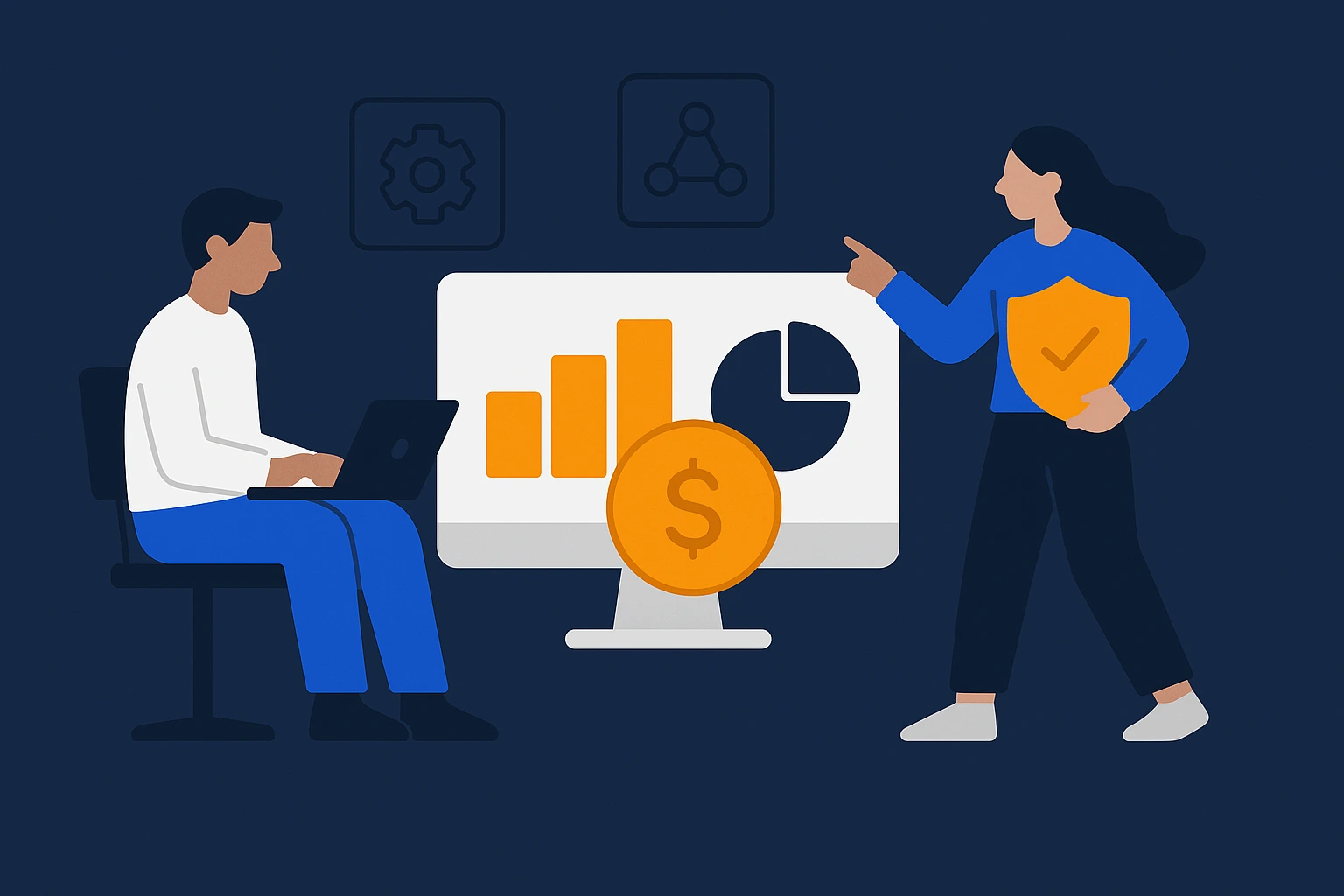Introduction
Run cost is the silent tax on growth. As cloud footprints, feature sets, and integration surfaces expand, the ongoing cost to operate your web application or mobile platform can outpace revenue gains—especially when environments multiply and usage patterns fluctuate. For product leaders, the mandate is clear: keep shipping faster without letting unit economics drift.
At CoreLine, we help leadership teams embed cost accountability into product development, UX, and platform operations. This article outlines a pragmatic approach to run‑cost governance—think FinOps with a product lens—so you can scale an MVP, modernize an enterprise application, or launch a new digital product without surprise opex.
Whether you’re seeking a partner for enterprise application development, a custom web app development agency to extend your team, or mobile app consulting to streamline your release cadence, the following blueprint shows how to hardwire financial clarity into your product decisions.
What run‑cost governance means for product leaders

Run‑cost governance is the operating model that ties product scope, architecture choices, environment strategy, and operational practices to measurable financial outcomes. It goes beyond “cloud cost optimization.” The goal isn’t just a smaller bill; it’s predictable, defensible unit economics at feature, tenant, and customer‑segment levels.
In practice, that means:
- Defining cost metrics that a product manager can use during prioritization (not just after a monthly invoice).
- Establishing architectural guardrails that favor cost‑efficient patterns by default.
- Eliminating “unknown unknowns” in pre‑production environments where waste hides.
- Turning incident, reliability, and performance data into directional cost signals for roadmap trade‑offs.
When done well, you get a clear picture of how changes in UX scope, integrations, rollout strategies, and SLAs affect the total cost to serve—and how those decisions map to revenue.
The four layers of run‑cost governance

1) Business layer: cost as a product metric
Embed cost into your definition of success alongside acquisition, activation, and retention. Treat cost to serve as a first‑class KPI.
- Cost per active user (or per MAU/WAU) by plan and segment.
- Cost per key transaction (e.g., checkout, quote, scan, sync, inference).
- Cost per tenant for multi‑tenant systems (baseline + feature deltas).
- Unit cost of reliability (what a 9 adds to opex given your SLAs).
- Run cost per environment (dev, QA, UAT, perf, staging) and per team.
These metrics translate directly into backlog conversations—especially when you’re engaging MVP development services to move fast but still need to safeguard margins.
2) Architecture layer: choose patterns that scale cost‑linearly
Architectural patterns have cost signatures. Make those signatures explicit in your ADRs and design reviews.
- Stateful vs. stateless: favor stateless paths for bursty workloads; reserve stateful where it creates real differentiation.
- Storage classes and data lifecycle: right‑tier from day one; design archival and deletion as core features, not chores.
- Fan‑out integrations: cap concurrency, batch where user experience allows, and decouple partner calls through queues.
- Caching and edge strategy: treat cache effectiveness as a cost lever, not just a performance tweak.
- ML/AI features: establish model‑inference budgets and choose deployment targets (device, edge, serverless) based on steady‑state economics, not just accuracy metrics.
If you’re engaging a digital product design agency, align UX flows with these cost profiles early to avoid rework.
3) Delivery layer: environments without waste
Most waste doesn’t happen in production. It hides across dev/test environments, zombie resources, oversized CI agents, and long‑lived feature branches.
- Environment policy: time‑boxed ephemeral environments spun from templates; automatic teardown on PR merge/close.
- Data policy: synthetic or masked datasets sized to the test; avoid cloning production scale unless validating performance.
- CI/CD cost controls: size runners for actual needs; throttle heavy test suites; gate expensive builds behind feature flags or labels.
- Observability by environment: attribute costs and telemetry to owners and epics to make waste socially visible.
For teams partnering with a custom web app development agency, agree on an environment “bill of rights” in the SOW to prevent who‑pays‑for‑what disputes later.
4) Operations layer: reliability that pays for itself
Reliability investments should reduce churn, support costs, and run cost over time.
- SLOs as cost commitments: target SLOs where the ROI is clear; every extra “9” should justify its incremental opex.
- Progressive delivery: use canaries, region waves, and feature flags to cap blast radius and rollback cost.
- Autoscaling policy: set floor/ceiling rules that reflect diurnal and seasonal patterns; don’t let safety margins become the default allocation.
- Incident economics: record not just MTTR but the direct operational cost of incidents to steer future work.
This layer is where mobile app consulting often uncovers low‑hanging fruit: reducing unnecessary background tasks, rescheduling syncs, and shrinking SDK footprints can yield meaningful savings at scale.
A reference model you can put to work
Here’s a compact model to align cost with product outcomes.
- Objectives: maximize gross margin per customer segment while protecting NPS and feature adoption.
- Key results:
- Reduce cost per active user by 20% over two quarters without impacting retention.
- Cut non‑production opex by 35% via ephemeral environments and right‑sizing.
- Shift 30% of inference workload to lower‑cost execution targets with no UX regression.
- Initiatives:
- Cost‑aware ADRs and UX reviews.
- Unit‑economics dashboards for PMs and finance.
- Environment lifecycle automation.
- Feature‑level cost flags at rollout.
From MVP to scale: where costs creep—and how to prevent it
Scaling MVPs into market‑ready applications introduces hidden multipliers.
- “Temporary” services become permanent: sunset plans and exit criteria must be in every integration ADR.
- One‑size SLAs: map support tiers to customer value; don’t give enterprise‑grade guarantees to entry‑level plans.
- Analytics sprawl: define event budgets by surface and retire unconsumed events quarterly.
Partnering with experienced MVP development services can help you avoid ossifying early choices that inflate opex later.
Pricing, packaging, and the cost to serve
Run‑cost governance informs pricing and packaging—not the other way around.
- Meter by value proxy: align cost drivers (compute, storage, requests) with user‑perceived value (analyses, seats, projects).
- Anchor plans to SLOs, limits, and entitlements that have known cost curves.
- Use feature flags for plan enforcement so you can model cost deltas before public rollout.
For enterprise application development, bake these constraints into procurement‑ready documentation to speed security and architecture reviews.
The 90‑day rollout plan
A practical sequence we run with product teams:
- Days 0–15: Discovery
- Inventory environments, top workloads, SLAs, and analytics events.
- Define product‑level cost KPIs with finance and PMs.
- Days 16–30: Baselines
- Tag resources and map workloads to features/tenants.
- Stand up dashboards for cost per user/transaction/environment.
- Days 31–60: Controls
- Implement ephemeral environments and teardown policies.
- Introduce cost‑aware ADR templates and UX review checkpoints.
- Establish SLOs and progressive delivery for the top 3 high‑cost flows.
- Days 61–90: Optimization and handoff
- Right‑size top 10 workloads; convert quick wins into guardrails.
- Pilot pricing/packaging adjustments informed by cost insights.
- Formalize a monthly run‑cost review with product, engineering, and finance.
Tooling without tool‑sprawl
You don’t need a new platform to start. Most teams succeed with:
- Resource tagging standards and enforced templates.
- Dashboards that combine cost, usage, and SLOs per feature.
- IaC policies to prevent noncompliant resources.
- Release workflows that require cost impact notes for material changes.
The crucial pattern is ownership: each metric and environment needs a clear, named owner.
Event/Performer Details
- Title: Run‑Cost Governance for Enterprise Applications — Executive Workshop
- Format: 45‑minute briefing + 30‑minute Q&A
- Hosts: CoreLine product consulting and engineering leads
- Audience: CEOs, CTOs, CFOs, product directors, and engineering managers
- Location: Online (private session for your leadership team)
- Date: On‑demand; sessions available upon request
- Deliverables: Customized 30‑day plan, KPI framework, and governance checklist
Why You Shouldn’t Miss It
- See exactly how to translate cloud invoices into product‑level unit economics.
- Learn how to set SLOs that improve customer outcomes without inflating opex.
- Get an environment strategy that cuts non‑production costs—fast.
- Understand which UX and architecture decisions have the biggest cost signatures.
- Walk away with a 90‑day plan tailored to your platform and growth goals.
Practical Information
-
Who it’s for
- Product leaders preparing to scale an MVP or consolidate platforms.
- Technology and finance leaders seeking shared, actionable cost metrics.
- Teams engaging a custom web app development agency or digital product design agency and needing clear run‑cost roles and responsibilities.
-
What you’ll get
- A compact KPI set: cost per active user, transaction, tenant, and environment.
- An ADR and UX review template that bakes in cost signatures.
- An environment lifecycle policy with teardown automation guidelines.
- A monthly run‑cost review cadence and ownership model.
-
How to prepare
- Bring a list of top customer journeys and their current SLAs.
- Identify your most expensive workloads and environments (or best estimates).
- Clarify growth scenarios for the next two quarters (new features, markets, or integrations).
-
Engagement options
- Advisory sprint: 2 weeks to baseline, prioritize, and implement quick wins.
- Pilot implementation: 4–6 weeks to operationalize dashboards, policies, and guardrails across one product area.
- Ongoing governance: quarterly reviews and roadmap alignment with your leadership team.
Conclusion
Run‑cost governance is a product capability, not a procurement chore. When unit economics show up in every design critique, ADR, and release note, teams ship with confidence—and your margins hold as you scale. If you’re evaluating enterprise application development support, considering mobile app consulting to improve release quality, or looking for MVP development services that won’t balloon opex down the line, we’re ready to help you operationalize this playbook and tailor it to your context.
To request the executive workshop or discuss a tailored engagement, contact our team.



